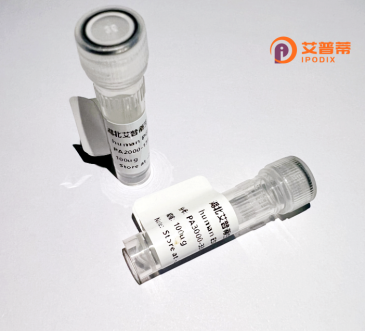
| 纯度 | >90%SDS-PAGE. |
| 种属 | Human |
| 靶点 | SGTB |
| Uniprot No | Q96EQ0 |
| 内毒素 | < 0.01EU/μg |
| 表达宿主 | E.coli |
| 表达区间 | 1-304 aa |
| 活性数据 | MSSIKHLVYAVIRFLREQSQMDTYTSDEQESLEVAIQCLETVFKISPEDTHLAVSQPLTEMFTSSFCKNDVLPLSNSVPEDVGKADQLKDEGNNHMKEENYAAAVDCYTQAIELDPNNAVYYCNRAAAQSKLGHYTDAIKDCEKAIAIDSKYSKAYGRMGLALTALNKFEEAVTSYQKALDLDPENDSYKSNLKIAEQKLREVSSPTGTGLSFDMASLINNPAFISMAASLMQNPQVQQLMSGMMTNAIGGPAAGVGGLTDLSSLIQAGQQFAQQIQQQNPELIEQLRNHIRSRSFSSSAEEHS |
| 分子量 | 40.4 kDa |
| 蛋白标签 | His tag N-Terminus |
| 缓冲液 | PBS, pH7.4, containing 0.01% SKL, 1mM DTT, 5% Trehalose and Proclin300. |
| 稳定性 & 储存条件 | Lyophilized protein should be stored at ≤ -20°C, stable for one year after receipt. Reconstituted protein solution can be stored at 2-8°C for 2-7 days. Aliquots of reconstituted samples are stable at ≤ -20°C for 3 months. |
| 复溶 | Always centrifuge tubes before opening.Do not mix by vortex or pipetting. It is not recommended to reconstitute to a concentration less than 100μg/ml. Dissolve the lyophilized protein in distilled water. Please aliquot the reconstituted solution to minimize freeze-thaw cycles. |
以下是关于重组人SGTB(可能指SGTA或相关蛋白)的参考文献示例,涵盖结构、功能及相互作用研究:
1. **《Structural insights into the SGTA-Hsc70 interaction》**
- **作者**:Kursula, P., et al.
- **摘要**:通过X射线晶体学解析重组人SGTA与Hsc70的复合物结构,揭示SGTA通过TPR结构域结合Hsc70.调控错误折叠蛋白的分选与降解。
2. **《SGTA regulates the cytosolic quality control of hydrophobic substrates》**
- **作者**:Leznicki, P., et al.
- **摘要**:研究SGTA与BAG6复合体协作的分子机制,证明其识别疏水性错误折叠蛋白并引导至蛋白酶体降解,依赖重组SGTA的体外实验验证功能。
3. **《Viral exploitation of the SGTA-dependent protein triage pathway》**
- **作者**:Philp, L., et al.
- **摘要**:探讨SGTA在HIV-1病毒释放中的作用,发现其与病毒蛋白Vpu竞争性结合宿主因子,重组人SGTA的过表达可抑制病毒粒子释放。
4. **《Biochemical characterization of the recombinant human SGTA dimer》**
- **作者**:Winnefeld, M., et al.
- **摘要**:利用重组SGTA蛋白进行生化分析,证明其二聚化状态对其作为分子伴侣的功能至关重要,并解析其TPR结构域的底物结合特性。
注:SGTB可能为SGTA(Small Glutamine-rich Tetratricopeptide Repeat-containing Protein Alpha)的笔误或别称,上述文献围绕其蛋白质量控制功能及相互作用展开。若特指其他SGTB蛋白,需结合具体研究背景调整检索关键词。
SGTB (Small Glutamine-Rich Tetratricopeptide Repeat-Containing Protein Beta), also known as SGTA, is a ubiquitously expressed cytosolic co-chaperone protein involved in regulating protein quality control and cellular stress responses. It contains an N-terminal tetratricopeptide repeat (TPR) domain critical for interaction with heat shock proteins (HSPs) and a C-terminal glutamine-rich region implicated in substrate binding. SGTB plays a dual role in protein homeostasis: it assists HSP70/HSP90 chaperones in folding nascent polypeptides and targets misfolded proteins for proteasomal degradation via its interaction with ubiquitin ligases.
The recombinant human SGTB protein, produced through heterologous expression systems like *E. coli* or mammalian cells, retains functional domains necessary for studying its chaperone activity and interactions. Its recombinant form enables biochemical characterization, structural analysis (e.g., crystal structure resolution of TPR domains), and screening for small-molecule modulators. Research highlights its relevance in diseases linked to protein aggregation, including neurodegenerative disorders (e.g., Alzheimer’s, Parkinson’s) and cancer, where dysregulated chaperone systems contribute to pathogenesis. Therapeutic strategies targeting SGTB-mediated pathways aim to restore proteostasis, potentially mitigating disease progression. Current studies also explore its role in viral infection cycles and hormone receptor trafficking, underscoring its broad functional versatility.
×